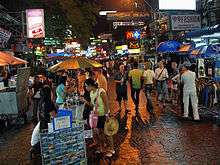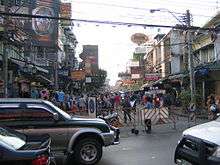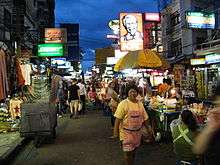Khaosan Road
| ถนนข้าวสาร | |
 | |
| Location | Bangkok, Thailand |
|---|---|
| Coordinates | 13°45′32″N 100°29′50″E / 13.75889°N 100.49722°ECoordinates: 13°45′32″N 100°29′50″E / 13.75889°N 100.49722°E |

Khaosan Road or Khao San Road (Thai: ถนนข้าวสาร) is a short (410 meter long) street in central Bangkok, Thailand constructed in 1892 during the reign of Rama V.[1] It is in the Bang Lamphu area of Phra Nakhon District about 1 kilometre (0.62 mi) north of the Grand Palace and Wat Phra Kaew.
Background
"Khaosan" translates as "milled rice", a hint that in former times the street was a major Bangkok rice market.[1] In the last 20 years, however, Khaosan Road has developed into a world-famous "backpacker ghetto".[2][3] It offers cheap accommodation, ranging from "mattress in a box"-style hotels to reasonably priced three-star hotels. In an essay on the backpacker culture of Khaosan Road, Susan Orlean called it "the place to disappear."[4]
Despite its reputation a diverse group of travellers can be found on Khao San Road.[3]
In this small area one can observe the interactions and groupings of disparate characters such as well-educated young Westerners on extended leave from affluent society, high school graduates on gap year travels, Israelis fresh out of military service, university students on holiday or sabbatical leave, young Japanese in rite-of-passage attire, ordinary holidaymakers, (ex-) volunteers from various organizations, and the like.
— Anders Sørensen, Annals of Tourism Research
It is also a base of travel: coaches leave daily for all major tourist destinations in Thailand, from Chiang Mai in the north to Ko Pha Ngan in the south, and there are many relatively inexpensive travel agents who can arrange visas and transportation to the neighbouring countries of Cambodia, Laos, Malaysia, and Vietnam.
Khaosan shops sell handicrafts, paintings, clothes, local fruits, unlicensed CDs, DVDs, a wide range of fake IDs, used books, and other useful backpacker items.[5]

During late evening, the streets turn into bars and music is played, food hawkers sell barbecued insects, exotic snacks for tourists,[6] and there are also local people selling ping pong shows.
There are several cafes, pubs and bars where backpackers meet to discuss their travels.[7] The area is internationally known as a center of dancing, partying, and just prior to the traditional Thai New Year (Songkran festival) of 13–15 April, water splashing that usually turns into a huge water fight.[8] One Thai writer has described Khaosan as "...a short road that has the longest dream in the world".[9]
A Buddhist temple under royal patronage, the centuries-old Wat Chana Songkram, is directly opposite Khaosan Road to the west, while the area to the northwest contains an Islamic community and several small mosques.[10]
Conflict
In July 2018, the Bangkok Metropolitan Administration (BMA), in an attempt to clean up the area, announced that Khaosan street vendors would be removed from the thoroughfare from 1 August 2018. The BMA intends to move them to a nearby area and restrict their trading hours to 18:00 to midnight.[11] The Khaosan Street Vendors Association, representing some 300 vendors, rejected the move, citing financial ruin for vendors.[12] Last-minute negotiations between the BMA and vendors proved fruitless as neither side has been willing to compromise.[13] Khaosan vendors announced that, in defiance of BMA order, they will open as usual on 1 August.[14] On the first day of the ban on stalls, roughly 70 percent of the vendors opened as usual in defiance of the police.[15][16]
See also
References
- 1 2 "Khao San Road". aecnews.net. Asia Pacific Daily. Archived from the original on 2015-11-24. Retrieved 2016-12-11.
- ↑ "Nights in the backpacker ghetto". Mail Online. Retrieved 2016-12-11.
- 1 2 Sørensen, Anders (2003-10-01). "Backpacker ethnography". Annals of Tourism Research. 30 (4): 847–867. doi:10.1016/S0160-7383(03)00063-X.
- ↑ Susan Orlean, "The Place to Disappear", in The Best American Travel Writing 2001, Jason Wilson and Paul Theroux, eds. (Mariner Books, 2001), pp. 228–237.
- ↑ "Khao San Road Shopping - Where to Shop and What to Buy in Khao San Road". bangkok.com. Retrieved 2016-12-11.
- ↑ "Khao San Road - Backpackers' haven" (Video). Bangkok Post. Retrieved 2016-12-11.
- ↑ Richards, Greg; Wilson, Julie (2004-01-01). "15". The Global Nomad: Backpacker Travel in Theory and Practice. Channel View Publications. ISBN 9781873150764.
- ↑ "Khao San Songkran shortened to 2 days to save water". Coconuts Bangkok. 2016-04-08. Retrieved 2016-12-11.
- ↑ "Literal Backpacker's Mecca in Bangkok Khao San Road". Thailand for You. Retrieved 2015-09-07.
- ↑ Mahavongtrakul, Melalin (2015-10-27). "Bangkok's Islamic quarters". Bangkok Post. Retrieved 2016-12-11.
- ↑ Ellis-Petersen, Hannah (4 August 2018). "'It's a shocking idea': outcry over Bangkok street vendor ban". The Guardian. Retrieved 5 August 2018.
- ↑ Panyasuppakun, Kornrawdee (31 July 2018). "Khaosan vendors call on BMA to scrap ban on pavement stalls". The Nation. Retrieved 31 July 2018.
- ↑ "City Hall to enforce footpath vending ban on Khao San Rd". Bangkok Post. 31 July 2018. Retrieved 31 July 2018.
- ↑ Saksornchai, Jintamas (31 July 2018). "Khaosan Vendors to Defy City Hall's New Rules". Khaosod English. Retrieved 31 July 2018.
- ↑ Panyasuppakun, Kornrawee (2 August 2018). "Khaosan vendors brazenly defy BMA's ban on pavement trading". The Nation. Retrieved 2 August 2018.
- ↑ "Vendors ignore ban on road stalls on Khao San". Bangkok Post. Reuters. 2 August 2018. Retrieved 2 August 2018.
External links
| Wikimedia Commons has media related to Khaosan Road. |


- Khaosan Road Survival Guide
- Ultimate Guide to Khao San Road